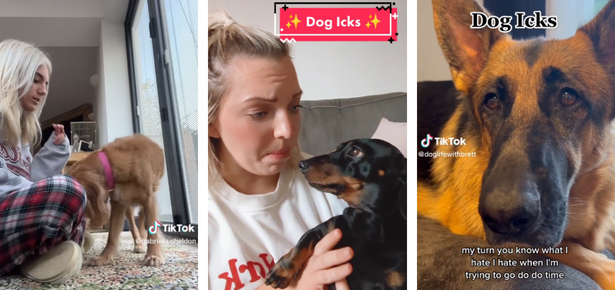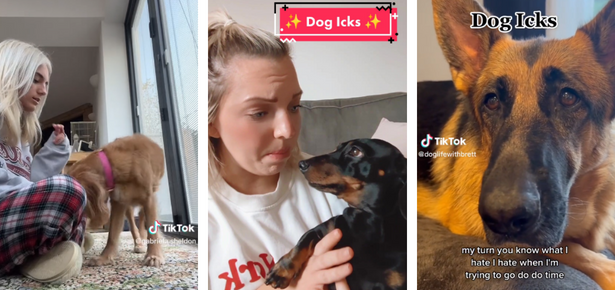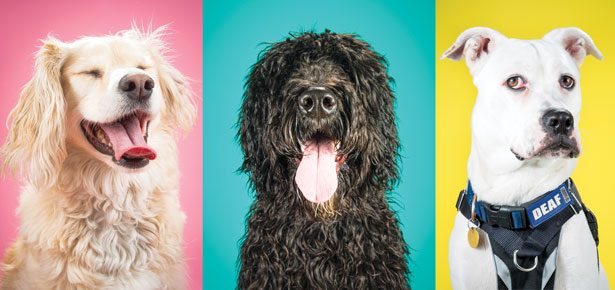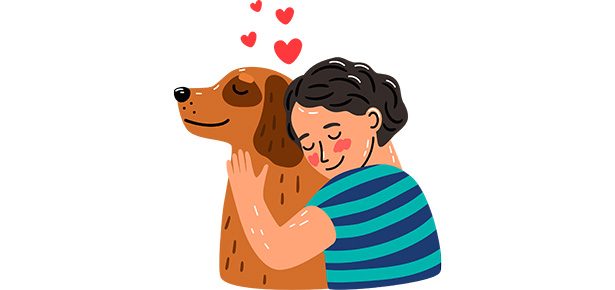

Does Your Dog Give You The Ick?
Veterinarian shares how to beat TikTok’s trending icks
TikTok users are now extending the dating term ‘the ick’, referring to being suddenly put off by someone you were once attracted to, to their dogs.
In candid videos, dog owners can be seen reeling off their dogs’ traits that irk them the most, often joined by their oblivious four-legged friend!
Dog owners can be seen reeling off their dogs’ traits that irk them the most, often joined by their oblivious four-legged friend! However, although many traits are innocent, cheeky mistakes, according to Pooch & Mutt’s in-house Veterinary Surgeon, Dr Linda Simon, most have a simple explanation and can be easily fixed with training and time.
1. Being dramatic about nail trims
Explanation: It’s very normal for dogs to resist having their nails trimmed because it's unfamiliar with their daily routine. If your dog isn’t introduced to nail clippers at a young age or regularly visiting the groomer, touching their paws and nails will be an unfamiliar experience. Some dogs might also associate nail trimming with a negative experience, which can lead to anxiety and fear.
How to fix it: If you want to cut your dog's nails at home, slowly introducing nail clippers can make the experience more relaxing. First, get your dog comfortable with having their paws and nails touched by you and rewarding this behaviour. You can then introduce the nail clippers and let your pup get used to seeing them or just putting the clippers next to, or on, their paws. Provide positive reinforcement with treats and praise as you do this.
You can even try snipping dry pieces of pasta and following with a reward so your dog gets used to the sound of the nail being cut. It’s important to take a lot of care when trimming your dog's nails to avoid cutting the very sensitive living quick that runs through the core of their nails.
If your dog is still hesitant after continuous training, seek the advice of a professional groomer or veterinarian who will be well-trained in trimming nails quickly and efficiently. You can also try training with a scratchboard (essentially a large nail file for dogs) or having more regular walks on concrete or pavement to increase the time between trims.
2. Licking your face
Explanation: Whilst a little lick on your cheek every once in a while is usually quite sweet and is often your dog's way of showing affection and bonding with you, over-enthusiastic licking of your face and mouth can be gross, knowing where your dog’s mouth and tongue have been!
Other reasons your dog might like licking your face include getting your attention, trying to groom you or even as a sign of submission. The most common reason is your dog's highly developed sense of taste – our skin is salty and tastes great to our pooches!
How to fix it: If you want your dog to respect your personal boundaries (and hygiene!), practice redirecting their attention to a toy or treat when they try to lick your face. You can also practice the “off” command. It’s important to be patient when teaching your dog any command but positive reinforcement and consistency will reduce the face licking in no time.
3. Having to bribe them to do anything!
Explanation: Using food, treats and toys as rewards every time you give your dog a command can feel like you constantly have to bribe them, but truthfully, offering rewards is just a great method of training and reinforcing positive or good behaviour. It can also help build your dog's confidence and trust in you as an owner.
How to fix it: Dogs are highly motivated by rewards, but these don’t have to be tangible. Some dogs are motivated by verbal and physical praise from their owners, like cuddles and scratches, whereas others will be over the moon just going on a walk with their human best friend. Working dogs may also find the opportunity to engage in activities like herding or retrieving as rewards too.
So, while it may seem like you’re constantly bribing, remember that understanding what motivates your dog is one of the most effective ways to train them and build your relationship.
4. Having so many toys, but still rather chewing cardboard
Explanation: There are a few reasons why your dog would rather chew cardboard than play with their toys. If your pup has regular access to their toys, an object like a cardboard box will be much more interesting to explore than toys they may be more familiar with. The texture may also appeal to their chewing instincts, especially with teething puppies.
Chewing any cardboard they can get their paws on can also signify boredom and indicate that your dog needs more mental stimulation.
How to fix it: If you find it’s happening often, try enrichment activities like playing with them, walking, or a quick training session. Some pups may also chew on objects as a way to cope with anxiety and stress.
While chewing on plain cardboard is fine, you must ensure your dog is not ingesting large pieces, as this can cause blockages in their digestive system. To minimise any cardboard chewing habits, I’d recommend not giving your dog constant access to their toys, e.g. a toy basket, and instead bringing different toys out daily for a playing session before storing them away to keep them new and interesting objects for your dog to explore and play with you.
You can also give them other safe and appropriate chews like antlers, buffalo horns and ostrich bones – just be sure to monitor chewing at all times. If your dog consistently chews non-food items like cardboard, it’s a good idea to talk to your veterinarian to rule out any underlying health issues.
5. Begging every time you eat
Explanation: All dogs are interested in human food for the exact same reasons as us – smell and taste! Their olfactory receptors are, after all, a thousand times more sensitive than ours, so it’s no wonder they’re prone to salivating and staring at you with longing eyes every time you sit down to eat.
However, food fixation is often an issue caused by us as owners by reinforcing the behaviour. If we offer our dog too many “human treats” or allow them to beg in the kitchen or at the dinner table and then reinforce this behaviour by giving them a piece of food, they learn that begging is a behaviour that gets them what they want, which can lead to bad habits. Your dog may also learn that begging for food is a behaviour that gets your attention.
How to fix it: If you can’t resist the puppy-dog eyes, try establishing clear boundaries around feeding by creating separation, like sending them to their bed. If your dog is crate trained, this is also a good way to create boundaries around meal times. Training them to go to a designated spot during your meal times and rewarding this will eventually teach your pup that begging is not rewarded, but being in their designated spot is.
Be sure to ignore all begging behaviour and not give in by feeding them scraps or human food while cooking or eating. Be consistent and patient with your training – eventually, your dog will learn to respect your space while you enjoy your meals!
6. Being lazy
When talking about laziness in relation to dogs, we first have to be sure that any low energy levels are not any underlying health or behavioural issues. If you notice a sudden change in your dog's energy or behaviour, always consult with a veterinarian first to rule out any health problems like obesity, arthritis or other chronic conditions.
Explanation: In healthy dogs, laziness can be down to a few different factors like breed, age, and even temperament. Just like humans, some dogs are naturally more laid-back than others. Breeds like Great Danes, Bulldogs and Basset Hounds are also known for being more laid-back and less active than other breeds, and for some dogs, as they age, you’ll find they like to spend more time resting.
How to fix it: However, it’s important to ensure your dog isn’t becoming lazy due to lifestyle or environment. Dogs need exercise and mental stimulation – if they don’t get enough of this, they may become lazy and uninterested. Equally, dogs that are kept in smaller living spaces or don’t have access to outdoor spaces and activities may also become bored and, as a result, less active.
If you think your dog is a little on the lazy side, be sure to keep up the exercise with walking, jogging and games of fetch. You can also adjust the environment, so if you walk in the same park throughout the week, try switching up the route on the weekend to allow your pup to explore new environments and keep them mentally stimulated and engaged. Mentally stimulating activities like puzzles, scatter feeding, obedience training and hiding treats will also help challenge their minds and keep them engaged.
Join the newsletter and never miss out on dog content again!
"*" indicates required fields
By clicking the arrow, you agree to our web Terms of Use and Privacy & Cookie Policy. Easy unsubscribe links are provided in every email.





